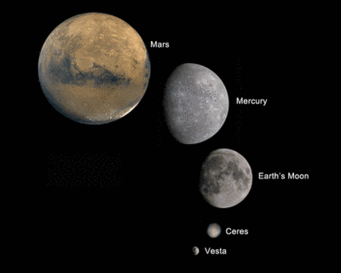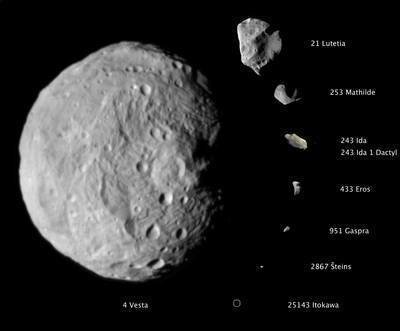Science
Vesta und Ceres - two dissimilar sisters
The bodies Vesta and Ceres, that orbit the Sun in a distance of more than 300 million kilometers within the asteroid beilt, could not be more different: Vesta once had an interior that was so hot, that its heavy components sank deep within. In this way, a layered structure emerged. Ceres, however, was most likely a rather cold body, under whose surface possibly frozen or even liquid water can be found. Despite these severe differences, both bodies are only a 60 million kilometers apart. They therefore mark the transition that takes place within the asteroid belt from the solid inner planets (Mercury, Venus, Earth, and Mars) to the distant gas giants (Jupiter, Saturn, Uranus, and Neptune) and their moons, that mainly consist of helium, hydrogen, and methane. In addition, Vesta and Ceres allow for a look back into an early phase of our solar system. Both bodies could not develop into large planets, but remainded stuck in early phases of planetary evolution. Almost all other bodies either merged to form larger planets or broke into smaller fragments as a result of heavy collisions.
The formation of planets
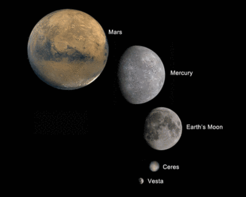
Approximately 4.5 billion years ago, our solar system looked completely different than today. Instead of today's eight planets, a cloud of gas and dust (later a disc) rotated around the newly created Sun. Apart from hydrogen and helium this original matter consisted mainly of oxygen, carbon, nitrogen, silicon, magnesium and iron.
Due to the influence of gravitation, over time irregularly formed lumps clumped together that by and by reached diameters of several kilometers. Due to further collisions these chunks merged, grew even more and developed into protoplanets: smaller still than today's planets, but already of uniform shape and with a structured inner composition.
With time the gravitational force of these protoplanets attracted all other matter - until their surroundings were largely cleared. Only in the so-called asteroid belt between the orbits of Mars and Jupiter there was a different development. There the influence of proto-Jupiter prevented further planets from forming. The protoplanets Vesta and Ceres therefore remained “stuck” in an early phase of their development. Their inner structure has hardly changed in the last 4.5 billion years. The newly born planetary system changed due to the influence of the Sun. Due to its heat and the barrage of charged particles the inner planets lost their gaseous components. The outer planets and their moons however remained rich in water.
Vesta - built like an onion
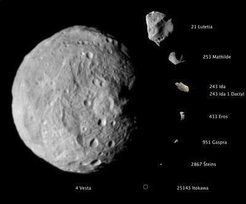
Vesta is unique in many respects as the extensive measurements performed by the Dawn mission in 2011 and 2012 have proven. Since then, Vesta is believed to be the only known (and only „surviving“) protoplanet. In protoplanets enough mass has accumulated to create an almost spherical shape and a layered inner structure. But in comparison to today's planets, they are rather tiny.
Both characteristics apply to Vesta. With a diameter of approximately 530 kilometers Vesta is significantly larger than almost all other bodies within the asteroid belt. But even the diameter of Mercury, the smallest planet, exceeds this by approximately a factor of ten. In addition, the new measurements show, that similar to the inner planets Mercury, Venus, Earth, and Mars Vesta consists of three layers: a rocky crust, a rocky mantel, and a core. Vesta is the smallest known celestial body which is built like an onion. While the core probably consists mainly of iron and nickel, mantel and crust are built primarily of silicates. The core’s radius could be more than 100 kilometers. The crust could possibly have a thickness of 22 kilometers. Vesta’s exact inner building is still part of scientific research.
To achieve such a layered structure, Vesta must once have been hot and molten. Only in this scenario can heavy components sink into the interior to form the core. Scientists suspect, that when Vesta originated approximately 4.5 billion years ago the protoplanet contained radioactive aluminum from a supernova outside of the solar system. This aluminum served as fuel. However, Vesta quickly cooled off. And since – unlike in the case of Earth – the pressure inside Vesta is not high enough to keep core and matel in a liquid state, soon all volcanic activity subsided.
But even without volcanism, the protoplanet Vesta can look back on a turbulent past that modified its outer appearance significantly. The images obtained by the Dawn spacecraft show that two violent asteroid impacts unsettled Vesta's southern hemisphere: two to three billion years ago the so-called Veneneia basin was formed in this manner; later the huge Rheasilvia basin and in its center a huge elevation, which is 22 kilometers high and therefore comparable in height with Olympus Mons on Mars. Vesta’s northern hemisphere is covered with craters.
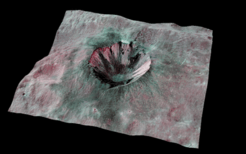
This last impact tore so much material out of the protoplanet that a new class of asteroids was formed, the so-called Vestoids. Also, most of the representatives of a group of meteorites, the so-called HED-meteorites, can be traced back to Vesta. These meteorites, that mainly consist of howardite, eucrite, and diogenite, constitute approximately six percent of all meteorites found on Earth. The comparison of laboratory studies and measurements performed by Dawn were now able to prove, that Vesta is really the mother asteroid of these fragments.
In addition, the impacts brought extraneous material to Vesta. Vesta's surface has surprised scientists with its strong differences in brightness that are unlike anything known so far from other bodies in the solar system. While the brightest material reflects light like snow, the dark regions are nearly as black as coal. The distribution of this dark material, that is rich in carbon, indicates that it was brought to Vesta by many impacts of asteroids. The material also contains the mineral serpentine. This finding leads to conclusions about Vesta’s environmental conditions. Vesta was once hot and melted. As serpentine cannot survive high temperatures, it must have come to Vesta later and consequently have a foreign origin. Impacts of primitive asteroids probably once brought the material to Vesta. A volcanic origin can therefore be excluded.
Ceres - a world built on ice
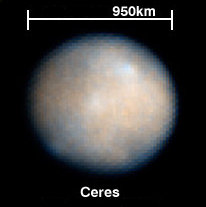
The dwarf planet Ceres is the larger of the two dissimilar sisters and almost spherical in shape. However, only little is known of its properties and structure. The low density indicates that Ceres does not have a metallic core. Researchers suspect, that under as little as a few centimeters thick layer of possibly watery clay there is a layer of frozen water and maybe additionally of liquid water. The core could consist of a mixture of rock and ice. In its composition Ceres is therefore similar to Jupiter’s moons Ganymede and Callisto. Some scientists also believe that Ceres has frozen polar caps that evaporate in summer. This theory is based on indications that from the north pole of the asteroid a compound of oxygen and hydrogen escapes. The Herschel mission has also shown that Ceres emits water vapor into space from time to time.
All this points to Ceres being a cold body, that never possessed a hot interior. Why Ceres did not (like Vesta) collect radioactive aluminum and heat up, is still unclear. But perhaps under Ceres' primitive surface there is a layered inner structure after all – even if in a different form than in the case of Vesta.
